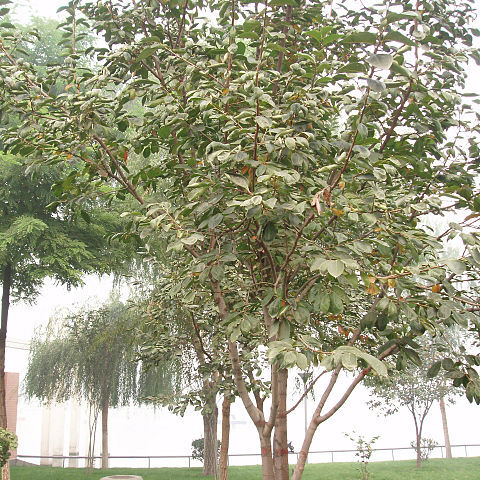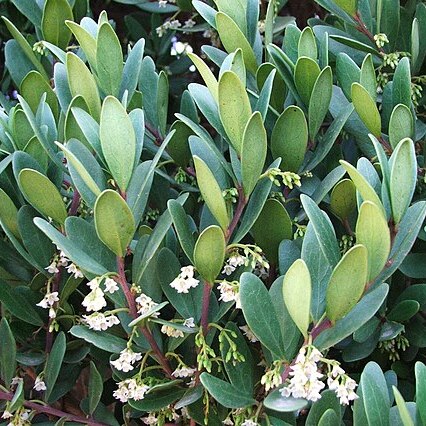Dioecious or rarely monoecious (not in Australia), andromonoecious or polygamomonoecious (not in Australia) shrubs or trees, usually with black bark, wood and roots. Leaves simple, entire, alternate, rarely opposite or whorled (not in Australia), petiolate, usually with dark-coloured nectaries abaxially; stipules absent. Flowers actinomorphic, usually unisexual, rarely bisexual (not in Australia), axillary. Female flowers usually solitary, with staminodes or lacking stamens. Male flowers usually in cymes, rarely in racemes (not in Australia), fascicles or panicles (not in Australia), or solitary, with a vestigial pistil or lacking pistil (not in Australia). Sepals 3–7, fused, persistent and usually enlarging in fruit, valvate or imbricate (not in Australia) in bud. Petals 3–7, fused, convolute, rarely imbricate or valvate (not in Australia); corona rarely present (not in Australia), 8-lobed, contorted, adnate to corolla. Stamens fused to the base of petals or attached to receptacle, usually 2–5 times as many as petals, rarely as many as petals and alternating with them; filaments free or united in pairs or threes; anthers tetrasporangiate, dehiscing by longitudinal or subapical slits. Ovary superior or inferior (not in Australia), 2–16-locular; ovules 1 or 2 per locule; placentation apical; styles 2–8, free or basally united; stigmas entire or bilobed. Fruit a succulent, leathery or rarely dry and tardily indehiscent (not in Australia) berry, few to several seeded. Seeds usually oblong.
Shrubs or trees, sap watery. Leaves alternate [rarely opposite or whorled], simple; stipules absent; petiole present; blade margins entire. Inflorescences axillary cymes [rarely racemes or panicles] or solitary flowers. Flowers unisexual, rarely bisexual; perianth and androecium hypogynous; sepals [3-]4-5[-8], connate at least proximally; petals [3-]4-5[-8], connate proximally; staminate flowers: stamens [1-]3-4[-5] times as many as [rarely fewer than] petals; filaments inserted on corolla tube (rarely on receptacle), distinct or connate in superposed pairs; anthers dehiscent by longitudinal or subapical slits; pistillodes often present; pistillate flowers: staminodes often present; pistils 1, [2-]4-5[-8]-carpellate; ovary superior [rarely inferior], [3-]8[-16]-locular; placentation apical-axile; ovules anatropous, bitegmic, tenuinucellate, nucellus scant; styles [1-]4(-5)[-8], variously connate [distinct], often bifid apically; stigmas [1-]4(-5)[-8], apical. Fruits usually baccate [rarely capsular, tardily dehiscent]. Seeds 1-2 per locule or fewer by abortion, reddish or brown to black, ± oblong, usually bilaterally flattened; embryo straight to slightly curved; endosperm hard (sometimes ruminate), oily.
Trees or erect shrubs, occasionally with spine-tipped branchlets. Leaves alternate, rarely opposite, entire; stipules absent. Flowers actinomorphic, usually unisexual, dioecious, or polygamous, rarely bisexual. Male flowers often in cymes, sometimes in clusters or solitary; pistil rudimentary or absent. Female flowers often solitary, axillary, imperfect or without stamens. Calyx 3--7-lobed, persistent and often becoming enlarged in female or bisexual flowers; lobes abutting or overlapping in bud. Corolla 3--7-lobed; lobes convolute, rarely overlapping or abutting. Stamens hypogynous or at bottom of corolla, 2--4 X as many as corolla lobes, rarely as many as corolla lobes and alternate with them; filaments free or united in pairs. Ovary superior, 2--16-locular; ovules 1 or 2 per locule. Styles 2--8, free or basally united; stigma entire or 2-lobed. Fruit a ± fleshy berry, with few to several seeds. Seeds usually oblong; endosperm sometimes ruminate; hilum small.
Ovary syncarpous, 2–8–carpellary, each carpel bi–ovulate and usually completely or incompletely divided by a false septum into 2 uni–ovulate locules; styles equal in number to the carpels, distinct or basally connate, very rarely completely united; stigmas usually large and conspicuous; ovules apical, pendulous, anatropous, with 2 integuments
Ovary syncarpous, each locule either with 2 ovules or divided by a false septum into 2 uni-ovulate compartments; styles distinct or basally connate, very rarely completely united; stigmas usually large and conspicuous; ovules pendulous from apex of locule
Stamens from (2) 3 to more than 100, epipetalous or borne on receptacle, exserted or included; filaments often very short; anthers basifixed, usually apiculate and setulose, often of unequal size and 2 or more arising from a single filament
Inflorescence sometimes cauline, determinate, usually cymose or fasciculate but sometimes a simple or branched false raceme, or reduced to a solitary flower which usually terminates a bracteate peduncle
Stamens from 2 to more than 100, epipetalous or borne on receptacle, exserted or included, filaments often very short, anthers usually apiculate, often 2 or more arising from a single filament
Flowers actino-morphic, hypogynous, usually unisexual, but frequently with rudiments of other sex, solitary, fasciculate or cymose, rarely in false racemes, sometimes cauliflorous
Endosperm abundant, hard, horny, smooth or ruminate; embryo usually about half as long as the seed; radicle large, superior; cotyledons foliaceous
Corolla gamopetalous, shortly to deeply lobed; tube sometimes fleshy and constricted at the throat; lobes contorted sintrorsely in bud
Seeds large; endosperm abundant, hard, sometimes ruminate; embryo half as long as the endosperm, with foliaceous cotyledons
Corolla gamopetalous, shortly to deeply lobed; tube often fleshy and constricted at throat; lobes contorted in bud
Calyx gamosepalous, entire and truncate to deeply lobed, always persistent in fruit and usually accrescent
Flowers actinomorphic, hypogynous, unisexual, but usually with rudiments of the other sex, 3–8–merous
Calyx gamosepalous, entire to deeply lobed, always persistent in fruit and usually accrescent
Trees or shrubs without milky latex, heartwood sometimes black (Ebony of commerce)
Pistillode very variable in development, rarely completely absent
Seeds large, with a distinct circum–peripheral vascular loop
Leaves simple, exstipulate, usually alternate and entire
Fruit usually a berry, rarely showing tardy dehiscence
Staminodes very variable in development, rarely absent
Leaves nearly always alternate, exstipulate, entire
Trees, shrubs or suffrutices without milky latex
Hilum small, apical, inconspicuous
Testa coriaceous (parenchymatous)
Heartwood sometimes black
Disk present or absent
Fruit a berry


